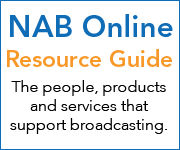|
|

|
Accounting
for Receiver Performance in Improving Spectrum Efficiency:
The Middle Class Tax
Relief and Job Creation Act of 2012 (referred to informally by broadcasters
as the Spectrum Act) was signed into law on February 22 2012 and,
among other things, authorized the use of "incentive auctions"
of broadcast spectrum. As a result, the FCC has issued a Notice
of Proposed Rule Making on various aspects of conducting incentive
auctions of broadcast spectrum; comments were filed on January 25
and reply comments are due on March 12. However, another part of
the Spectrum Act that perhaps got fewer headlines, headed "Study
on Receiver Performance and Spectrum Efficiency," required
the U.S. Comptroller General (essentially the Government Accountability
Office or GAO) to conduct a study that has just been released on
the effect of adjacent spectrum on wireless transmission systems,
encompassing all telecommunications, broadcast, satellite, commercial
mobile service, or other communications systems that employ radio
spectrum. "(1)
the value of- (A) improving receiver performance as it relates to increasing spectral efficiency; (2) the role of manufacturers, commercial licensees, and government users with respect to their transmission systems and the use of adjacent spectrum; (3) the feasibility of industry self-compliance with respect to the design and operational requirements of transmission systems and the reasonable use of adjacent spectrum; and (4) the value of action by the Commission and the Assistant Secretary to establish, by rule, technical requirements or standards for non-Federal and Federal use, respectively, with respect to the reasonable use of portions of the radio spectrum that are adjacent to each other." The deadline for the report was one year after the date of enactment of the Spectrum Act, and GAO released its report to Congress and the public on time on February 22, 2013. The 48-page report details the results of GAO's interviews with industry and government representatives and their own analysis conducted between July 2012 and February 2013 on the relationship of receiver performance with interference mitigation and spectrum efficiency. Figure 4 from the report, copied below, shows pictorially the interference situation that is attributable to receiver performance in adjacent channel situations. The report notes that the FCC and NTIA have primarily focused on setting emission limits on transmitters and/or establishing spectrum guard bands to control interference. Mandates on receiver performance have been routinely used by NTIA for federal spectrum users, but rarely used by the FCC for commercial services. NTIA indicated that their mandatory standards for receivers apply to about 60 percent of federal spectrum assignments. In commercial industry, it has been more popular for industry-led organizations to adopt voluntary standards for receivers. For instance, for television service, the Advanced Television Systems Committee (ATSC) developed and maintains the A/74 "Recommended Practice on Receiver Performance Guidelines." The GAO report summarized their research and found several challenges to further improvements in receiver performance: Lack of coordination
across industries: Lack of incentives
to improve receivers: Difficulty accommodating
a changing spectrum environment: The report documents various efforts that have been taken over the years by industry and the FCC with regard to receiver performance. However, the Recommendation at the end of the report implies that more needs to be done at the government level: "To improve receiver performance and spectrum efficiency, we recommend that the Chairman of the FCC consider collecting information on the practical effects of various options to improve receiver performance, including consideration of small-scale pilot tests of these options." The GAO report "Spectrum Management: Further Consideration of Options to Improve Receiver Performance Needed" can be downloaded here. In the year that the
GAO report was being prepared, work in other venues on the subject
was also ongoing. On November 29, 2012 the House Energy and Commerce
Committee's Subcommittee on Communications and Technology held a
hearing on "The
Role of Receivers in a Spectrum Scarce World." During that
hearing, the FCC's Deputy Chief of the Office of Engineering and
Technology noted that "receiver performance is becoming increasingly
important as a limiting factor as we move to repurpose spectrum
and pack services closer together on the spectrum chart." He
also indicated that the FCC planned to review the upcoming report
from GAO, as well as output expected from the FCC Technological
Advisory Council (TAC). Join this free webinar
on Thursday February 28 at 1:00 pm Eastern for an executive summary
of the state of "4K' and "8K" versions of Ultra-HD
technology and a view on what must be done to enable Ultra-HD service.
Sponsored by US Telecom, the webinar will be led by consultant Greg
DePriest (former VP, Technology for NBC Universal) who led the Washington,
D.C. private demonstrations of "8K" Ultra-HD technology
during the recent London Olympic Games in cooperation with NHK,
BBC and OBS. For more information and to register for the webinar,
click here. |
|||
|
|
|||



